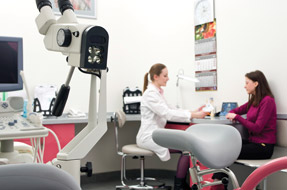Improving rural health takes effort, energy
The need for improvements in the prevention of obesity and diabetes rates in poor and underserved communities has driven new outreach programs that range from smoking cessation in high school to dietary support in grocery stores.
Although he was on medication, an 80-year-old patient was being hospitalized every 2 to 3 months for congestive heart failure. Only once he began seeing a prevention nurse in a special heart failure clinic every week did his condition improve. Eventually, with meticulous medication titration, he was seen every 2 weeks by the nurse, then monthly, and was no longer being hospitalized.
His physician, N. Burgess Record Jr., MD, FACP, recalled, “He was happy, the nurse was happy because she was functioning at a higher level, and I was happy because instead of spending an hour with him once a week I could spend 5 minutes and the nurse 30 minutes. In the end we all would agree on next steps.”

Dr. Record pointed to this clinical example of his long-time work on communitywide prevention in a rural setting, described in an article in the Jan. 13 Journal of the American Medical Association. By developing and sustaining outreach programs addressing issues ranging from smoking cessation programs in high schools to dietitian support in grocery stores with positive results, he and colleagues accomplished something that's garnering attention.
“The study is very good news because it ... documents an effort to implement, monitor, and evaluate a major community effort to improve cardiovascular health,” said Darwin R. Labarthe, MD, PhD, MPH, professor of preventive medicine at the Northwestern University Feinberg School of Medicine in Chicago and co-author of an accompanying JAMA editorial.
The study looked at all 150,000 1-on-1 patient contacts by nurses and other health coaches of the Franklin Cardiovascular Health Program, conducted over 40 years in worksite, school, community, and clinical settings. The results showed an increase of 24.7% in hypertension control from 1975 to 1978, an increase of 28.5% in cholesterol control from 1986 to 2010, and an increase from 48.5% to 69.5% in smoking cessation rates from 1996 to 2000, along with reduced hospitalization and lower adjusted mortality rates among residents of one of the poorest counties in Maine. The lower hospitalization rates accounted for $5.5 million in health care savings annually.
The need to focus on prevention continues given today's rising obesity and diabetes rates, especially in poor rural and other underserved communities.
Yet some contend that the changing business climate for physicians, especially the move to hospital employment, and other pressures make it difficult to replicate efforts of Dr. Record and his colleagues.
“It's harder to do what they did as primary care physicians now because we're being pulled in a lot of directions,” said ACP Member Clifton Smith, MD, an internist at Mid-Maine Medicine in North Vassalboro, Maine. “I still see my main job as taking care of the patient sitting in front of me. ... The thought of participating in running a population health program seems daunting.”

There's hope, however, that such efforts will get a boost from the Affordable Care Act (ACA). Not only will the legislation bring more patients into the system, but its public health and preventive services fund may also encourage hospitals to put resources, such as training for community health workers, into these communitywide efforts, Dr. Labarthe said.
In the meantime, he said, while it's not necessarily practical for primary care physicians in rural or underserved areas to take the lead in these efforts, they shouldn't underestimate their influence in supporting them.
In fact, the key to the success in Franklin County was that it was not so much the work of 1 physician, Dr. Labarthe pointed out, but the “integration of effort between clinical care and community outreach activities.”
What worked
Dr. Record and his wife, Sandra S. Record, RN, both now living in Saco, Maine, co-founded and co-directed and managed the Franklin Cardiovascular Health Program from its first hypertension screening in 1974 through subsequent additions of cholesterol, smoking, diet, and physical activity until their retirements.
Support was critical: More than 200 volunteer nurses went to 16 towns in the county. They screened and coached patients who might otherwise not make it to a clinic by meeting them in churches, schools, and libraries, as well as at 60 worksites. They sent patient data on food intake, exercise, medication adherence, mental health issues, and smoking back to the physicians. Program nurses referred patients to the doctors for care, and doctors sent patients to program nurses for interval monitoring between doctor visits.
To address the population's literacy challenges, they created education materials on a 4th- or 5th-grade reading level, said Sandra Record, who co-authored the JAMA article. They also held support groups, some led by dietitians.
The Records started their work in 1973, when Rural Health Associates (RHA), a new, innovative multispecialty group practice, gave them the opportunity to pursue prevention both within and outside traditional clinical boundaries. With federal funding, RHA set up a health insurance program for thousands of medically indigent people.
Despite the positive results—or perhaps in part because of them—the local hospital may have suffered. The millions saved went mostly to insurers to help cover the cost of care in the rest of Maine, not to Franklin Memorial Hospital, which bore the financial brunt of reduced admissions, Dr. Record said. “Nonetheless, the hospital continues to support key elements of the program, including practice-based nurse co-management in all of its primary care practices, financial measures to assist needy patients, and Maine's first and continuing Healthy Community Coalition,” he said. “It costs money to do prevention, but you don't make money doing it.”
Can it be done?
Although it's encouraging from a prevention perspective to see what was accomplished in Franklin County, it may be even more difficult to duplicate in today's health care environment.
Dr. Smith, who became employed by MaineGeneral Health a year ago, sends his patients to a community care team from Kennebec Region Health Alliance (KRHA), a physician hospital organization.
“It's not perfect. There are still a lot of unmet needs and patients who need help but decline it,” he said.
Most primary care physicians don't have the time or resources for the level of prevention efforts Dr. Record led, agreed Barbara A. Crowley, MD, executive vice president of MaineGeneral Health and president of KRHA in Augusta, Maine.
KRHA is focusing on population-based health care with the organization's 35 primary care practices. It uses nurses, social workers, and others to help identify patients who need support, then contacts them via phone calls and home visits. Integrating clinical and public health—just as Dr. Record did—is the goal, she said.
In New Ulm, Minn., a project launched in 2009 in partnership with the Minneapolis Heart Institute Foundation and Allina Health provides preventive interventions through nurses and dietitians to reduce myocardial infarctions and coronary heart disease risk.
As part of the Heart of New Ulm Project, primary care physicians initiate the outreach. Patients can then participate in weight loss programs or walking or running events or work with a nurse or dietitian to get coaching on lifestyle issues.
While the researchers are still crunching the numbers, the program appears to have yielded significant improvements in cholesterol and hypertension control, said cardiologist Michael Miedema, MD, a heart institute researcher. He pointed to significant improvement in patient use of aspirin as well.
The program's goal is to have 10 years of data on heart disease, heart failure, and stroke to see the impact of its interventions.
“Yes, it's difficult to replicate the kind of work Dr. Record did,” he said. “But it's definitely possible.”
Other challenges
Additional challenges for rural prevention programs, according to physicians, include the following:
Geographic isolation, which may not only put community physicians at a disadvantage in accessing resources but also makes transportation to a clinic or physician office a challenge for patients.
Demographics, including a rising number of elderly and decreasing birth rates. Risk factors add up for an aging population with lower economic status, Dr. Miedema said.
Income level, which can impact people's ability to pay for care or to find time to take advantage of care that is available.
Insurance availability and use, which can affect a patient's ability to access preventive services. Dr. Labarthe noted that the costs of using the insurance—co-pays, transportation costs, babysitting—can be a disincentive.
Culture, in which a patient looking for treatment for, say, a broken arm isn't necessarily interested in talking about smoking cessation. “The attitude is, ‘I don't need medical care. I don't need to go to the doctor. I'm feeling fine,’” Dr. Smith said.
Technology limitations, which for health care professionals can thwart efforts to track health-related data collected locally. For patients, access to mobile technology would help by, for example, using apps to track food purchases and consumption.
Infrastructure limitations, making it difficult for health professionals to connect with the community because there are few if any clinics or outreach settings and a limited number of clinicians.
Funding, with solutions varying from foundations to grants. Many are looking to the ACA's prevention incentives—”waiving cost sharing for preventive services, providing new funding for community preventive services, and creating workplace wellness programs,” according to the Centers for Disease Control and Prevention, to give a shot of adrenaline to communitywide prevention programs. Dr. Miedema said, “You're not billing RVUs [relative value units] when you're doing research, so you need some sort of funding.”
Manpower, making it difficult for short-handed rural practices to find time for larger population health efforts.
For example, David A. Fleming, MD, MA, MACP, immediate past president of ACP and professor and chair of medicine at the University of Missouri School of Medicine in Columbia, who is interested in rural placement, said that of the full complement of 70 residents and 60 fellows in subspecialty training in his department, very few choose primary care or choose to practice in rural settings. Having practiced in a rural community for 20 years, Dr. Fleming said that busy practices, lower salary, and lack of colleagues can discourage interest in doing primary care in remote areas.
Being shorthanded can short-circuit communitywide prevention efforts, said Raymond C. Christensen, MD, FACP, associate dean for rural health at the University of Minnesota Medical School in Duluth. He still works 1 day a week at the Gateway Family Clinic in Moose Lake, Minn.
“It's hard to do communitywide prevention if you're still filling slots,” he said.
The physician's role
For those interested and able to take first steps, Dr. Labarthe recommended taking a page from Dr. Record's experience and going where the patients are.
“Take information and programs [to the workplace or schools] to close the gap between the doctor and the community,” he said. “That's our lesson from Franklin.”
Dr. Fleming recalled exercising with his patients as part of a wellness and rehab program during his years working in rural Missouri. “I'd have a patient with chronic lung disease on my left and another with cardiovascular disease on my right,” he said.
To create synergy, reach out to other physicians and clinicians as well as persons of influence in the community to bring about change.
“Talk to other physicians and say, ‘We have a problem. How are we going to have an impact? Let's start with something we think we can do and do it together and see if we can mobilize community interest,’” Dr. Labarthe said.
Be sure that other doctors know you want to work with them collaboratively for the good of the patient and “not to take patients away from them,” Dr. Fleming said.
Don't aim at first for anything too complicated. “If it's too innovative, it's sometimes hard to get locals to buy into it,” he said.
Even with these initial efforts, though, physician involvement can be limited.
“We need population-based interventions,” said Dr. Miedema. “Physicians won't be the primary drivers, but they need to be involved in community programs.”
Perhaps their most important role is as a rallying point for the community, Dr. Labarthe said.
“If the physician doesn't say to the community, ‘We have a problem,’ the community thinks it has no problem. It's a matter of the physician becoming sensitive to, aware of, and empowered to address the community—not just the individual—as the patient,” he said. “The physician doesn't have to be at the forefront, but he can light a fire.”
Making a plan
Dr. Record recommended that physicians working in rural or underserved areas consider these first steps.
Familiarize yourself with local resources. What are housing and food options for patients who need them? How can patients access medical care and medications if they can't pay out of pocket? Is there any free dietary counseling? Where can patients go to walk in the winter? Make a checklist of those resources and make your staff aware of them. If possible, make it one staff person's responsibility to facilitate incorporation of these resources into the practice's day-by-day operations.
Maximize staff effectiveness. Ensure that everyone in your practice is working to the top of his or her license. For example, Dr. Record trained RNs to help co-manage patients with chronic conditions like high blood pressure, heart failure and diabetes with lifestyle management and medication adherence.
“It multiplies the effectiveness of the physician to have others who can talk, counsel, and coach, often even better than the physician,” Dr. Record said.
For example, Mrs. Record worked with a 52-year-old patient on medication for high cholesterol who had already had a heart attack. She brought in food models, looked through recipes with his wife, and discussed how to shop for healthier food and access a local school in the mornings to walk indoors during the winter. She followed him for 10 years, meeting with him every 6 months. He never had another heart event.
Find allies. “Hire a great nurse ... or marry one,” Dr. Record joked. Look to colleagues who share your enthusiasm for such an effort, then find hospital board members who might be interested as well. If possible, he said, go directly to the CEO to show that the effort worked well in Franklin County, that it can pay off under the Affordable Care Act, and that the hospital will engender good public relations that could give it a competitive edge.
Dr. Record said physicians shouldn't be discouraged by today's challenges. Instead of trying to tackle everything accomplished in Maine over 40 years, he suggested, start with high blood pressure or smoking, or whatever seems both important and feasible.
“Find the resources to support doing something new and different, then work hard at it,” he said. “Don't give up. It's possible to make a difference.”
At a minimum, look at data about cardiovascular health within your practice, Dr. Labarthe advised.
“My takeaway from the Maine study?” he said. “Go for it.”





